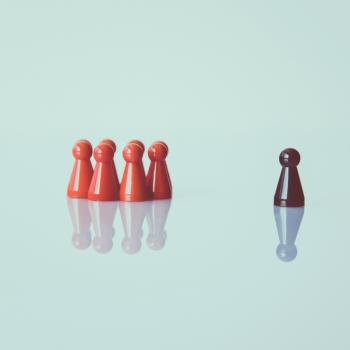Revelation 6:9-17 A Picture God’s Grace and God’s Judgment
The first four seals (6:1–8) function as preliminary judgments that God allows to operate throughout human history, sometimes resulting in the suffering of God’s people at the hands of sinners.1
The Fifth Seal: Persecution of the Saints
“When He opened the fifth seal, I saw under the altar the people slaughtered because of God’s word and the testimony they had.” (Revelation 6:9, HCSB)
What determines the killing of people? They are killed because of God’s Word (believing and submitting to the Bible) and sharing the Gospel. These are the weapons that Christians will use.
“Then I heard a loud voice in heaven say: The salvation and the power and the kingdom of our God and the authority of His Messiah have now come, because the accuser of our brothers has been thrown out: the one who accuses them before our God day and night. They conquered him by the blood of the Lamb and by the word of their testimony, for they did not love their lives in the face of death.” (Revelation 12:10–11, HCSB)
The only way that we conquer the Antichrist and the world system is by adhering to the Word and sharing the Gospel. But this will get Christians killed. These deaths are a picture of God’s grace.
The Plea
“They cried out with a loud voice: “Lord, the One who is holy and true, how long until You judge and avenge our blood from those who live on the earth?”” (Revelation 6:10, HCSB)
God’s Response: A Picture of God’s Grace on His People
One might think it strange that the killing of God’s people is an act of God’s grace. The grace in the fact that God comforts them after death.
“So a white robe was given to each of them, and they were told to rest a little while longer until the number would be completed of their fellow slaves and their brothers, who were going to be killed just as they had been.” (Revelation 6:11, HCSB)
The passive voice in “was given” suggests that God himself rewards them with white robes (see comment on 4:4), and that he himself responds to their plea.1323
“Some of the wise will fall so that they may be refined, purified, and cleansed until the time of the end, for it will still come at the appointed time.” (Daniel 11:35, HCSB)
Spirits without any substance could not wear robes. The fact that they will be given robes supports the concept that when believers die they are given temporary bodies in heaven which are later replaced by resurrection bodies at the time of resurrection (cf. 20:4).4
In all probability the souls of those who have been slain because of their testimony to Christ and because of their adherence to the word of God remain in a disembodied state until all the saints who are to be killed in the tribulation have completed their destiny.5
The Sixth Seal: Cosmic Disturbance – A Picture of God’s Judgment on Unbelievers
“Then I saw Him open the sixth seal. A violent earthquake occurred; the sun turned black like sackcloth made of goat hair; the entire moon became like blood; the stars of heaven fell to the earth as a fig tree drops its unripe figs when shaken by a high wind; the sky separated like a scroll being rolled up; and every mountain and island was moved from its place.” (Revelation 6:12–14, HCSB)
The martyrs cried, “Avenge us!” but the unbelievers on earth will cry, “Hide us!” The opening of the sixth seal will produce worldwide convulsions and catastrophes, including the first of three great earthquakes (Rev. 6:12; 11:13; 16:18–19). All of nature will be affected: the sun, moon, and stars, as well as the heavens, the mountains, and the islands. Compare this scene with Joel 2:30–31 and 3:15 as well as with Isaiah 13:9–10 and 34:2–4.6
“The sun will be turned to darkness and the moon to blood before the great and awe-inspiring Day of the Lord comes.” (Joel 2:31, HCSB)
“The mountains melt like wax at the presence of the Lord— at the presence of the Lord of all the earth.” (Psalm 97:5, HCSB)
“All the heavenly bodies will dissolve. The skies will roll up like a scroll, and their stars will all wither as leaves wither on the vine, and foliage on the fig tree.” (Isaiah 34:4, HCSB)
There is debate about whether the description depicts an actual dissolution of the cosmos (allowing room for metaphorical language to describe this dissolution) or whether it is a purely figurative description of the fall of ungodly kingdoms.7
Unbelievers’ Response:
“Then the kings of the earth, the nobles, the military commanders, the rich, the powerful, and every slave and free person hid in the caves and among the rocks of the mountains.” (Revelation 6:15, HCSB)
Three groups of unbelievers:
- The leadership
-
The rich and powerful
-
Everyone else
But John lists the entire social order in verse 15, emphasizing that no marks of distinction will exempt anyone from judgment—from the “divine” Caesar on down.2589
As in Isaiah 34, so also here these groups of people undergo divine judgment because they are an essential part of the corrupt world system that must be destroyed. In both cases the precise reason for punishment is the persecution of God’s people (cf. Isaiah 33:1–34:13; 35:1–4; Revelation 6:9–12)10
The kings … princes … generals … rich … mighty who experience God’s wrath ask a legitimate question: “Who can stand?” They are those who were “first” in the world system and who once held the keys to the powers and blessings of the secular kingdom. They now experience the same powerlessness of every slave; together they are “last” in God’s kingdom.11
“And they said to the mountains and to the rocks, “Fall on us and hide us from the face of the One seated on the throne and from the wrath of the Lamb, because the great day of Their wrath has come! And who is able to stand?”” (Revelation 6:16–17, HCSB)
‘Cover us,’ and to the hills, ‘Fall on us’” (cf. Hos. 10:1–3, 8; 11:2). The similar imagery of Jer. 4:29 is also included in the allusion, which enforces further in Rev. 6:16 the idea of judgment on idolaters who try to hide from God’s anger (cf. Jer. 4:23–30; 5:7). Behind Rev. 6:16, and even the Hosea and Jeremiah references, stands an allusion to the incident in Gen. 3 in which Adam and Eve “hid themselves from the presence of the Lord God” (3:8). God has thus designed history to end as it began.12
The deliberate irony of the phrase the wrath of the Lamb catches the reader’s attention. Mistaken are those explanations of this catchphrase that interpret Christ’s death as an act of personal or historical judgment against those who rejected him. It is best to take the phrase quite literally as the response of God’s enemies, whose terrifying experience of God’s anger results in a distorted understanding of the cross as God’s punishment rather than God’s forgiving mercy (Caird, Revelation, pp. 92–93). The slain Lamb is not finally a symbol of wrath (although Beasley-Murray, Revelation, p. 124); he is rather the symbol of God’s grace that purchased a people from death for eternal life.13
The Four Horsemen seals lead to the persecution of the saints in the fifth seal. The killings of the saints in the Tribulation leads to the cosmic disturbance. This cosmic disturbance acts as a sign that God is making clear that God’s grace period. In this case, this judgment is on the people of Jerusalem.
There is an interesting parallel between these six seals and the events that Jesus described in His confidential briefing to His disciples regarding His Second Coming.9 He spoke of false Christs, wars and rumors of wars, famines and pestilences, earthquakes, and cosmic changes of all kinds.14
But before considering John’s third theme in this section—redemption—we must note the parallels that exist between Christ’s prophetic words recorded in Matthew 24 and what John wrote in Revelation 6. The following summary outline makes this clear.
|
Matthew 24 |
Revelation 6 |
|
False Christs (vv. 4–5) |
White horse rider (vv. 1–2) |
|
Wars (v. 6) |
Red horse—war (vv. 3–4) |
|
Famines (v. 7a) |
Black horse—famine (vv. 5–6) |
|
Death (vv. 7b–8) |
Pale horse—death (vv. 7–8) |
|
Martyrs (v. 9) |
Martyrs under the altar (vv. 9–11) |
|
Worldwide chaos (vv. 10–13) |
Worldwide chaos (vv. 12–17) |
Matthew 24:14 introduces the preaching of the Gospel of the kingdom throughout the whole world, and this may well be where Revelation 7 fits in. God may use the sealed 144,000 Jews to share His Word with the world, resulting in the salvation of multitudes.15
1 J. Scott Duvall, Revelation, ed. Mark L. Strauss and John H. Walton, Teach the Text Commentary Series (Grand Rapids, MI: Baker Books, 2014), 106.
213 The “white” may reflect those purified by tribulation (Dan. 11:35; see Beale, Revelation, 394, 437).
3 Craig S. Keener, Revelation, The NIV Application Commentary (Grand Rapids, MI: Zondervan Publishing House, 1999), 220.
4 John F. Walvoord, “Revelation,” in The Bible Knowledge Commentary: An Exposition of the Scriptures, ed. J. F. Walvoord and R. B. Zuck, vol. 2 (Wheaton, IL: Victor Books, 1985), 948.
5 Paige Patterson, Revelation, ed. E. Ray Clendenen, vol. 39, The New American Commentary (Nashville, TN: B&H, 2012), 184.
6 Warren W. Wiersbe, The Bible Exposition Commentary, vol. 2 (Wheaton, IL: Victor Books, 1996), 589.
7 G. K. Beale and Sean M McDonough, “Revelation,” in Commentary on the New Testament Use of the Old Testament (Grand Rapids, MI; Nottingham, UK: Baker Academic; Apollos, 2007), 1105.
825 Many texts list similar distinctions (e.g., Plato, Theaetetus 175A; T. Abr. 19A). God’s judgment against the powerful (e.g., 1 Enoch 48:8; 54:2; 62:3–12; Sib. Or. 5.380) emphasizes his power and the pretentiousness of their arrogance.
9 Craig S. Keener, Revelation, The NIV Application Commentary (Grand Rapids, MI: Zondervan Publishing House, 1999), 222.
10 G. K. Beale and Sean M McDonough, “Revelation,” in Commentary on the New Testament Use of the Old Testament (Grand Rapids, MI; Nottingham, UK: Baker Academic; Apollos, 2007), 1105.
11 Robert W. Wall, Revelation, Understanding the Bible Commentary Series (Grand Rapids, MI: Baker Books, 2011), 113.
12 G. K. Beale and Sean M McDonough, “Revelation,” in Commentary on the New Testament Use of the Old Testament (Grand Rapids, MI; Nottingham, UK: Baker Academic; Apollos, 2007), 1105.
13 Robert W. Wall, Revelation, Understanding the Bible Commentary Series (Grand Rapids, MI: Baker Books, 2011), 112–113.
14 Chuck Missler, Learn the Bible in 24 Hours® (Nashville: Thomas Nelson, 2002).
15 Warren W. Wiersbe, The Bible Exposition Commentary, vol. 2 (Wheaton, IL: Victor Books, 1996), 589.












